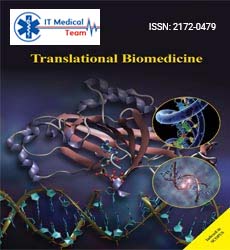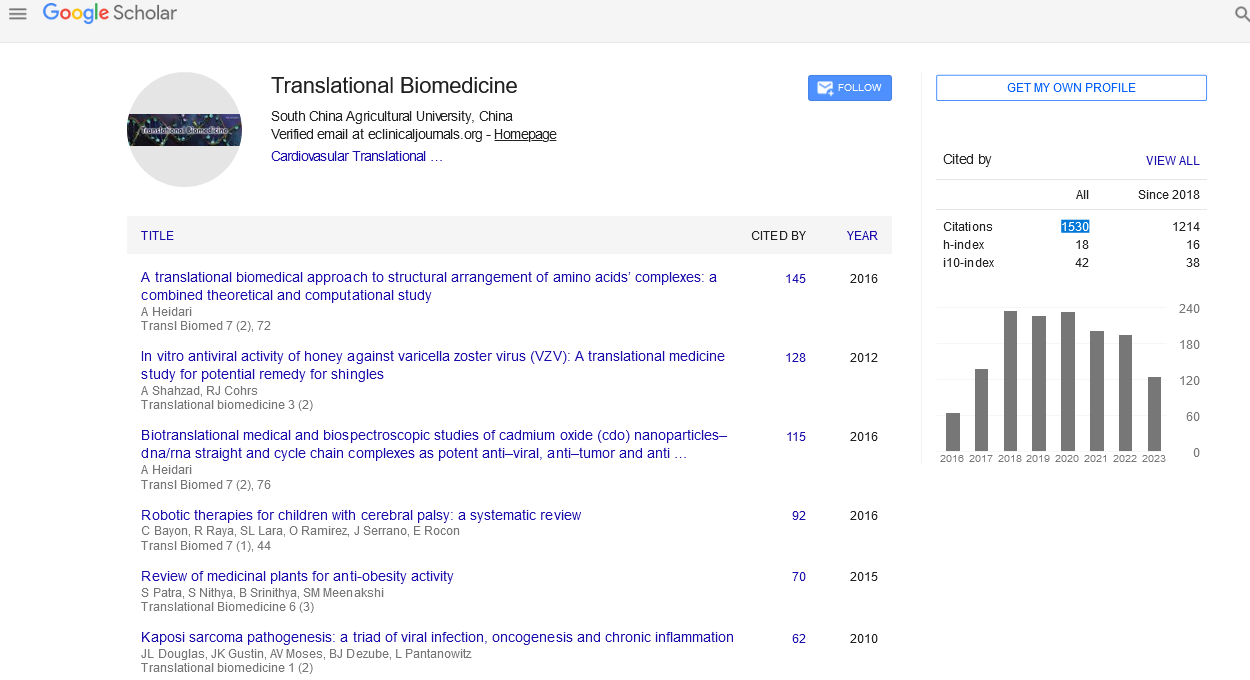Mini Review - (2022) Volume 13, Issue 6
Research in Oncology: By Anti-Cancer Therapies
Joaquim Cezar Felipe*
Department of Anatomy and Cell Biology, La Paz University Hospital, Spain
*Correspondence:
Joaquim Cezar Felipe, Department of Anatomy and Cell Biology, La Paz University Hospital,
Spain,
Email:
Received: 02-Jun-2022, Manuscript No. Iptb-22- 12882;
Editor assigned: 08-Jun-2022, Pre QC No. Iptb-22- 12882;
Reviewed: 22-Jun-2022, QC No. 12882;
Revised: 27-Jun-2022, Manuscript No. Iptb-22- 12882 (R);
Published:
01-Jul-2022, DOI: 10.21767/ 2172- 0479.100239
Introduction
The improvement of cancer survival is significantly aided by comprehensive cancer centres. With the hope that many European CCCs will strive for this rank, we have created an Excellence Designation System across Europe that consists of criteria to evaluate "excellence" in translational research. The Authors, 2015. Published on behalf of the Federation of European Biochemical Societies by Elsevier B.V. According to the CC BY-NC-ND licence, this article is open access. Finding factors that can support the success of translational cancer research is becoming increasingly important. Another top aim is to increase performance in order to shorten the time it takes to take successful innovations from the lab to the clinic and to return data from clinical studies to the lab for more research or the discovery of novel biology. The EU Sixth Framework Programme's decision to support clinical research for the first time was motivated by the rising incidence of cancer and the possibility that European cancer research may perform significantly better [1]. The EurocanPlus project, funded in October 2005, conducted a thorough assessment of European cancer research to identify hurdles to cross-national and intra- European collaboration between diverse stakeholders [2]. This project's primary findings included the necessity of strengthening inter-cancer research centre cooperation in order to reach critical mass and share the infrastructure required for ground-breaking translational cancer research. Being the only organisational form in which cancer treatment and care are intimately connected with research and education and, therefore, ideal for translational research, the idea of a Cancer Centre was considered to be of meaningful structure [3]. The EurocanPlatform, which combines 23 European cancer research centres and 5 cancer organisations to structure translational cancer research, was supported by the European Commission in 2011 as a continuation of the EurocanPlus initiative [4].This platform's long-term goal is to establish a sustainable translational cancer research platform with the critical mass of understand, assets, infrastructures, and patients required to promote innovation and enhance performance in all areas of cancer research, particularly translational research. Cancer Core Europe is recently established among six EurocanPlatform centres as an important first step toward the creation of such a platform [5]. A work package was made to generate a mechanism to identify "CCCs of Excellence" that could be eligible for future European funds, as requested by the EC. One of its main objectives was to provide a methodology for examining specific CCCs of Excellence in translational research. We previously outlined the processes that were taken to create a draught Excellence Designation System in order to achieve these goals [6]. This involved a 2-year process involving researchers, managers, physicians, and patient representatives from cancer institutions across Europe, but also evidence from one of the most recent literature. We now go over final EDS, which would have been produced in conjunction with the European Academy of Cancer Sciences and EurocanPlatform and tested with three European CCCs [7]. Dialogue is had concerning its relevance to CCCs and translational research During last decade, translational researchers have developed considerably, athere are many classifications available Only a small number, nevertheless, cover the entire cancer research continuum from bench to bedside and the converse [8]. Translational research highlighted the biological basis for observations obtained in cancer patients or populations at risk for cancer OR develops and tests the viability of cancerrelevant therapies in people using knowledge of human biology [9]. The term interventions is used in the broadest sense possible to refer to molecular assays, imaging technologies, medication, biological agents, and or other methodologies that are relevant to the prevention, early detection, diagnosis, prognosis, and or treatment of cancer [10]. This point of view is presented in three portions: an introduction to the EDS, that these we piloted with three European CC in September 2014 at the Helsinki University Central Hospital Cancer Centre, Cambridge Cancer Center, and The Netherlands Cancer Institute; a summary of the pilot results and the experiences of CCCs and peer-reviewers from partaking in the pilot; and a discussion of the system's suitability for translational oncology and a final section statement.
Discussion
European CCCs have also undergone series major national inspections. Additionally, they are responsible to European and
international evaluations, such as the Organization of European
Cancer Institutes' accreditation and designation scheme. The EDS
was of the position that it should not reinvent the wheel or add
more bureaucracy by designing up an entire new assessment
system. Hence, it bases itself into the regional and international
assessments. The OECI recognition & designation system, whom
the EDS criteria builds upon, and the facts that numerous
scientometric and quantitative studies are already a part of both
the OECI-system and other evaluation processes are the prime
motivations why EDS criteria are made descriptive.One
of the
leading causes of death in the world is cancer, and during the
past ten years, numerous research projects have concentrated
on developing novel treatments to lessen the adverse effects of
existing ones. As cancer progresses, tumours become extremely
heterogeneous, resulting in a mixed population of cells with a
variety of molecular characteristics and therapeutic responses.
This variability, which is crucial for the establishment of resistant
phenotypes encouraged by a selection pressure upon treatment
delivery, is discernible both at the geographical and temporal
levels. Typically, cancer is handled as a single, uniform disease,
and tumours are viewed as a whole cell population. Therefore,
a thorough knowledge of these complicated events is essential
for designing accurate and effective. In order to administer
traditional chemotherapeutic medications in vivo, increase their
bioavailability and concentration around cancer tissues, and
improve their release profile, Nanomedicine offers a flexible
platform of biocompatible and biodegradable technologies.
Nanoparticles can be used for a variety of purposes, including
therapy and diagnosis. Extracellular vesicles, which are involved
in the formation of cancer, the change of the microenvironment,
and the spread of metastatic disease, have recently attracted
a lot of attention as effective drug delivery systems. Due to
their anti-proliferative and pro-apoptotic qualities, numerous
phytochemicals and natural antioxidants have lately been used
as adjuvant medicines in the fight against cancer. Another
type of cancer treatment known as targeted therapy focuses
on one specific area, such as the intracellular organelles or
tumor vasculature, while sparing the surrounding tissue. This
greatly improves the treatment's specificity and minimizes its
disadvantages. Another potential possibility is based on gene
therapy and the production of genes that cause apoptosis and
tumor suppressors of the wild type, or the targeted silencing
mediated by siRNAs, which is now being tested in several
clinical trials across the globe. By allowing for the localization
of treatment in extremely small and precise locations, thermal
ablation of tumors and magnetic hyperthermia are creating
new possibilities for precision medicine. These techniques
might serve as an alternative to more intrusive procedures like
surgery. Additionally, emerging sciences like radiomics and
pathomics are assisting in the creation of creative methods for gathering massive amounts of data, developing novel therapeutic
approaches, and accurately predicting patient responses, clinical
outcomes, and cancer recurrence. Together, these approaches
will be able to offer cancer patients the greatest individualized
treatments, showing the value of fusing many fields to achieve
the best results.
Conclusion
Various approaches to cancer diagnosis and therapy will be
discussed, along with their current status in the clinical context,
underscoring their impact as cutting-edge anti-cancer strategies.
We will also provide a general overview of the most advanced
basic and applied cancer therapies in this review, along with
newly proposed methods that are currently under investigation
at the research stage that should overcome the limitations of
conventional therapies. Due to their small size and high surfaceto-
volume ratio, nanoparticles are peculiarly physicochemical
systems. In order to address some of the problems linked to
cancer treatment, biocompatible nanoparticles are used together
these approaches will be able to offer cancer patients the
greatest individualized treatments, showing the value of fusing
many fields to achieve the best results. Various approaches to
cancer diagnosis and therapy will be discussed, along with their
current status in the clinical context, underscoring their impact
as cutting-edge anti-cancer strategies. We will also provide
a general overview of the most advanced basic and applied
cancer therapies in this review, along with newly proposed
methods that are currently under investigation at the research
stage that should overcome the limitations of conventional
therapies. Due to their small size and high surface-to-volume
ratio, nanoparticles are peculiarly physicochemical systems.
In order to address some of the problems linked to cancer
treatment, biocompatible nanoparticles are used. Due to their
interaction with magnetic fields, super paramagnetic iron oxide
nanoparticles are frequently used as contrast agents in magnetic
resonance imaging. Ferumoxides ferucarbotran ferucarbotran
C, ferumoxtran-10, and NC100150 are the five SPIONs that have
been tested for MRI. Only a few nations still sell ferucarben, while
the others have had their markets shut down. Thermal ablation
and magnetic hyperthermia are two cancer treatments that
SPIONs have also been investigated for, and a kind of iron oxide
coated with aminosilane known as Nanotherm has already been
approved for the treatment of glioblastoma.
Acknowledgement
None
Conflict of Interest
None
References
- Kogler F, Sensken S, Airey JA (2004) A new human somatic stem cell from placental cord blood with intrinsic pluripotent differentiation potential. J Exp Med 200: 123-135.
Indexed at, Crossref, Google Scholar
- Marion RM, Strati K, Li H, Murga M, Blanco R et al. (2009) Â A p53-mediated DNA damage response limits reprogramming to ensure iPS cell genomic integrity. Nature 460: 1149-1153.
Indexed at, Crossref, Google Scholar
- Sadri Ardekani H, Atala A (2014) Testicular tissue cryopreservation and spermatogonial stem cell transplantation to restore fertility: from bench to bedside. Stem Cell Res Ther 5: 68.
Indexed at, Crossref, Google Scholar
- Woodsong C, Karim QA (2005) A model designed to enhance informed consent: experiences from the HIV prevention trials network. Am J Public Health 95: 412-419.
Indexed at, Crossref, Google Scholar
- Elsalanty ME, Genecov DG (2009) Bone grafts in craniofacial surgery. Craniomaxillofac Trauma Reconstr 2: 125-134
Indexed at, Crossref, Google Scholar
- Staerk, Staerk J, Dawlaty MM, Gao Q, Maetzel D et al. (2010) Reprogramming of peripheral blood cells into induced pluripotent stem cells. Cell Stem Cell 7: 20-24.
Indexed at, Crossref, Google Scholar
- Keung W, Boheler KR, Li RA (2014) Developmental cues for the maturation of metabolic, electrophysiological and calcium handling properties of human pluripotent stem cell-derived cardiomyocytes. Stem Cell Res Ther 5: 17.
Indexed at, Crossref, Google Scholar
- Chen JX, Krane M, Deutsch MA (2012) Inefficient reprogramming of fibroblasts into cardiomyocytes using Gata4, Mef2c, and Tbx5. Circ Res 111: 50-55.
Indexed at, Crossref, Google Scholar
Citation: Felipe JC (2022) Research in
Oncology: by Anti-Cancer Therapies. Transl
Biomed, Vol. 13 No. 6: 239.





